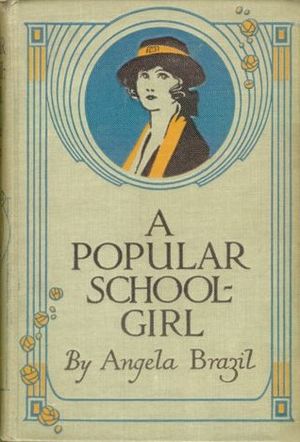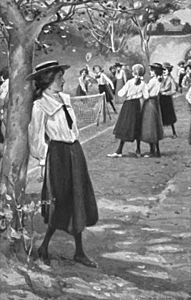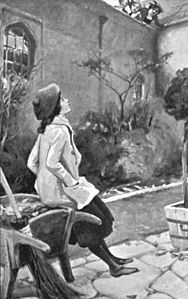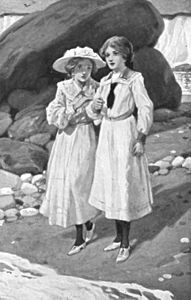Angela Brazil facts for kids
Quick facts for kids
Angela Brazil
|
|
|---|---|
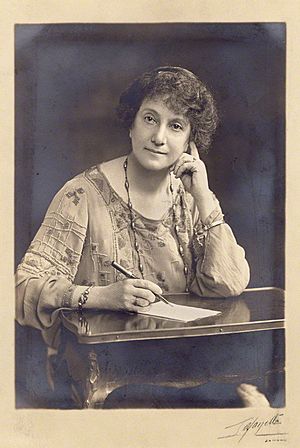
Angela Brazil, c. early 1920s
|
|
| Born | 30 November 1868 Preston, Lancashire, England |
| Died | 13 March 1947 (aged 78) Coventry, Warwickshire, England |
| Occupation | Children's book author |
| Nationality | English |
| Citizenship | British |
| Alma mater | Heatherley School of Fine Art |
| Period | 1904–1946 |
| Genre | School stories |
| Notable works |
|
Angela Brazil (born November 30, 1868 – died March 13, 1947) was a famous British writer. She was one of the first authors to write "modern schoolgirls' stories." Her books were written from the students' point of view. They were mostly for fun, not just to teach lessons.
In the early 1900s, Angela Brazil published almost 50 books for girls. Most of these stories were about boarding schools. She also wrote many short stories for magazines.
Her books were very popular and read by many young girls. Even though school stories became less popular after World War II, her books were still liked until the 1960s. Some adults thought her books were a bad influence. They even banned or burned them in some British girls' schools.
Angela Brazil's stories were new and exciting when they first came out. She helped change how fiction was written for girls. She showed young girls as active, aware of what was happening, and independent. She understood that being a teenager is a time of change. She also showed that girls have common interests and can work together.
Contents
Biography
Early Life of Angela Brazil
Angela Brazil was born on November 30, 1868, in Preston, Lancashire. She was the youngest of four children. Her father, Clarence Brazil, managed a mill. Her mother, Angelica McKinnel, came from a shipping family.
Angela's father was not very involved in his children's lives. Her mother, Angelica, had a different idea. She wanted her children to be creative and interested in things like books, music, and plants. This was different from how many parents acted in the Victorian era. Angela was also very close to her older sister, Amy, who had a big influence on her.
Her family moved often because of her father's work. They lived in Manchester and Bolton before settling in Bury.
Angela Brazil's School Days
Angela started school at age four but only lasted half a day! She was used to expressing herself freely. She surprised her teacher by pulling out her hairpins. This was not allowed in the strict schools of that time. She later attended schools like The Turrets in Wallasey and Manchester Secondary School.
Her final school was Ellerslie, an exclusive girls' school in Malvern, Worcestershire. She boarded there during her teenage years. Angela loved her school memories. She felt that to write for young people, you had to stay a "schoolgirl at heart."
After school, she studied art at Heatherley School of Fine Art in London with her sister Amy. She lived with her family for most of her life. After her father died in 1899, she traveled in Europe with her mother.
How Angela Brazil Started Writing
Angela Brazil began writing when she was just 10 years old. She made a magazine with her friend, Leila Langdale. It was like Little Folks, a children's magazine she loved. Their magazine had riddles, short stories, and poems. Angela even wrote a story called Prince Azib. Later, she actually published stories in Little Folks.
She started writing seriously for children in her 30s. Her first school story, The Fortunes of Philippa, was based on her mother's experiences. It was published in 1906. Her first children's novel to be published was A Terrible Tomboy in 1904.
Life in Coventry
Angela Brazil lived with her mother until her mother passed away. After that, she lived with her elder sister Amy and brother Walter. She moved to Coventry in 1911. She became a well-known person in the area.
She was known for hosting parties for adults, often with children's food and games. She also hosted many parties just for children, even though she didn't have any of her own.
Angela loved to read and collected old children's books. Her collection is now in Coventry library. She was also very interested in local history and helped with charity work. She cared about protecting land and old buildings. She never married.
Her Writing
Angela Brazil's Books and Publication
Angela Brazil started writing later in life. She was interested in Welsh mythology and first wrote magazine articles about myths and nature.
Her first published book was The Mischievous Brownie (1899), a collection of four children's plays. These plays featured fairies and ogres. Her family encouraged her to write for adults, but she wanted to write for children. She started her first full-length children's story, The Fortunes of Philippa, in the same year.
Her first novel to be published was A Terrible Tomboy (1905). This story was based on her own life, with Angela as the main character, Peggy. It was very successful, especially in the United States.
Her famous school stories began with The Fortunes of Philippa (1906). This book was based on her mother's experience of attending an English boarding school at age 10 after growing up in Rio de Janeiro. Her mother found the English culture and school life very different.
The Fortunes of Philippa was an instant hit. Angela Brazil soon received requests for more similar stories. She published 49 novels about boarding school life. She also wrote about 70 short stories for magazines. On average, she wrote two novels and five short stories each year.
Her books were mostly published by Blackie and Sons. They sold three million copies of her novels! Her most popular school story, The Nicest Girl in The School (1909), sold 153,000 copies. By 1920, school stories were the most popular type of book for girls.
Style and Themes in Her Stories
Angela Brazil is seen as the first writer of girls' school stories who wrote from the students' point of view. Her main goal was to entertain readers, not just teach them moral lessons. She wanted to write fun stories with ordinary characters. She wrote for girls who were gaining more freedom in the early 1900s. She aimed to capture their perspective.
Unlike many other writers, Brazil usually wrote new characters and schools for each book. She didn't often create long series about the same school. Her schools usually had between 20 and 50 students. This allowed them to feel like a big family but also like a small community with its own rules.
Her schools were often in beautiful places, like old manors or on clifftops. The teaching style was often new and exciting. It included things like self-expression, new exercises, and different activities for the girls.
The stories focus on the girls themselves, usually around 14 or 15 years old. They are lively and active. They are shown as normal teenagers going through changes. Their energy often leads to small adventures, like sneaking out of dorm windows or playing pranks. They also create their own secret languages and rules within the school.
Common events in her stories include secret night meetings, friendships, rivalries, and end-of-term concerts. These ideas have become very common in girls' school fiction since Brazil's time. She also wrote many school stories for children's annuals and The Girl's Own Paper.
Antecedents and Influences
Angela Brazil didn't invent school stories, but she greatly changed them. Stories about boarding school life already existed. The Governess; or, The Little Female Academy (1749) by Sarah Fielding is often seen as the first boarding school story. Fielding's book was more about teaching good behavior. However, it set up some ideas that Brazil later used, like a self-contained school community.
Other writers like Susan Coolidge (What Katy Did at School, 1873) and Frances Hodgson Burnett (Sara Crewe, 1887, later A Little Princess) also used school settings. But L. T. Meade was probably the most popular girls' writer before Brazil. Meade also used some new ideas in her school stories that Brazil later developed.
Literary and Social Context
More Girls Going to School
In the early 1900s, more middle-class girls started going to schools instead of being taught at home. Brazil's boarding school stories showed this change. They helped create a feeling that young women were a community with shared experiences. This meant girls could share their concerns and work together. Also, private schools for girls became more common and affordable.
Changes in Girls' Education
Angela Brazil's first school stories came out when more girls were learning to read. New education laws in 1902 and 1907 helped with this. Between 1900 and 1920, the number of girls in grammar schools grew a lot. School lessons for girls also became more open-minded. Boarding schools for girls became more respected. These schools offered many activities beyond just studying, like lacrosse, hockey, and fencing. This showed a wider change in society, where girls had more opportunities and could enjoy life more.
New Kinds of Girls' Fiction
Before Brazil, many girls' books taught lessons about being good, self-sacrificing, and fitting into society. Brazil's books were different. They featured energetic characters who sometimes challenged authority. They were cheeky, played pranks, and lived in a world where their youth was celebrated. Adults and their worries were not the main focus.
While girls loved Brazil's books, many adults did not approve. Some headmistresses even banned them, thinking they were bad for young minds. In 1936, a principal in London even said she would burn all of Brazil's books.
Brazil's own stories also changed over time. Her earlier books were more like Victorian girls' fiction. But after 1914 (the start of World War I), her heroines became more free and independent. This matched the changing opportunities and attitudes towards girls in society.
Influence
Angela Brazil is often seen as the person who started the girls' school story genre. Her books had a huge impact on what girls read for many years. Her ideas and themes became very common and inspired many other writers. For example, J. K. Rowling's Harry Potter series uses many ideas from English public school stories that Brazil helped make popular.
By the end of the 1900s, girls' school stories sometimes seemed a bit old-fashioned. They had common characters like the brave new girl or the fair headmistress. They also had repeating scenes like midnight feasts, pranks, and end-of-term concerts. Many funny copies of these stories have been made. However, when Brazil first wrote her schoolgirl tales, she was creating new ideas about girls' lives. Later writers simplified these ideas into common themes.
Popular writers of girls' school stories who read Angela Brazil's books include Elinor Brent-Dyer (who wrote the Chalet School series) and Enid Blyton (who wrote about Malory Towers and St Clares). Brent-Dyer's Chalet School series had 57 books and was still selling many copies in the late 1990s. Other important writers include Dorita Fairlie Bruce and Elsie J. Oxenham. Even today, these stories remain popular.
Example of illustration
The following illustrations were created by Arthur A. Dixon for Brazil's popular story The Nicest Girl in the School (1909).
See also
 In Spanish: Angela Brazil para niños
In Spanish: Angela Brazil para niños


